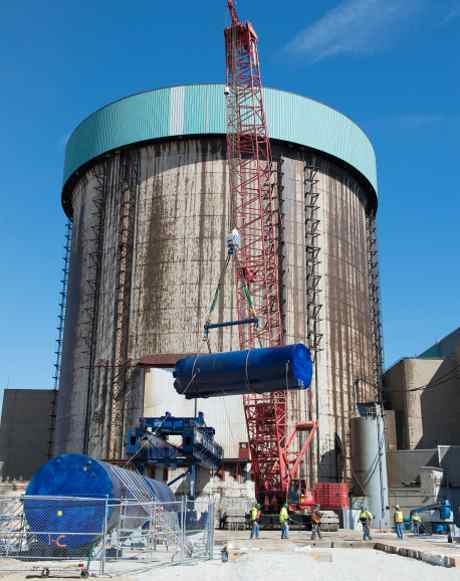EnergySolutions subsidiary ZionSolutions has successfully completed the sixth year of decommissioning work at the Zion nuclear power station with record setting performance, the company has announced. The project is on budget and ahead of schedule.
 |
| Large component removal was completed in March (Image: ZionSolutions) |
Zion's two pressurized water reactors (PWRs) on the shores of Lake Michigan were permanently shut down in 1998 for economic reasons after just over 20 years of operation. In 2007, owner Exelon contracted EnergySolutions to dismantle the plant, ship the waste to its disposal site in Utah, and return the Illinois site to greenfield status over a ten-year schedule.
The work begin in 2010 after the plant's licence and decommissioning funds were transferred to EnergySolutions. The site will be returned to Exelon about 2020. Used fuel will remain on the site in dry cask storage at an independent used fuel storage installation, known as an ISFSI, until a federal repository is available to receive the fuel.
EnergySolutions said on 25 October the decommissioning effort is currently 88% complete and several years ahead of the original ten-year schedule. The accelerated decommissioning schedule will directly translate into a lower overall decommissioning cost, the company said.
Achievements claimed by the project to date include the design and construction of the most modern and largest ISFSI for decontamination and decommissioning (D&D); a world record for the transfer of used fuel to the ISFSI of 366 days; an "industry first" in the successful segmentation, removal, transportation and disposal of both reactor vessels; and completion of the D&D industry's largest and most efficient major component removal and disposal project. Furthermore, projections indicate nearly a three-fold reduction in overall worker exposure compared to the previous industry best performance, the company said.
EnergySolutions president Ken Robuck said more than 98% of all the radioactive source term of the plant has now been removed, systematically lowering the project's execution risk. "Additionally, we anticipate a significant reduction in financial assurance requirements in early 2017 due to the accelerated completion schedule and our on-going successful performance of the project," he said.
The last of the plant's large components were removed from the site in March. Large components include steam generators, pressurizers, piping components, reactor coolant pumps and motors. Demolition of the turbine hall is now nearing completion, after which dismantlement of the containment buildings is to begin.
Researched and written
by World Nuclear News




_47120.jpg)

_23621.jpg)






